|
|
|
|
|
|
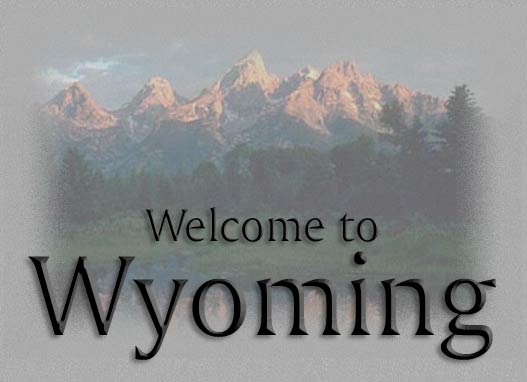
The "Equality State",
The "Cowboy State"
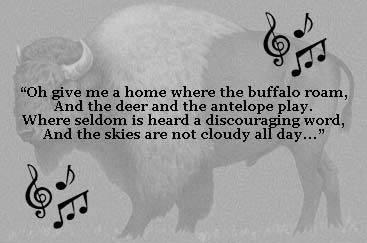
Since long before the area known as Wyoming became a state in 1890, civilization has been using the Southern corridor of this state for transportation, creating a rich heritage to be shared with visitors.
From dinosaur tracks to wagon tracks to railroad tracks to modern interstate highways, join us for a tour of an area rich in history called "the corridor".
What is the "Wyoming Corridor?"
The corridor is a significant historic transportation route containing rich resources from Wyoming's past. Prehistoric animals roamed the expanse, the mountain men explored the region and historic trails (Oregon, Overland, Mormon and Pony Express) crossed the landscape. Fossils, stage stops, railroad depots, roundhouses, seven National Register downtown areas, mining and timber camps and historic ranches all tell the story of the exploration and settlement of the state. The Old Lincoln Highway, Route 30, and today's Interstate 80 connect the resources of the auto age. Present day mines, oil fields, commercial areas, modern public facilities, and our people continue the saga.
The first tracks across Wyoming were American Indian trails connecting villages with hunting grounds. In the early 1800s, fur trappers and mountainmen refined these dim trails into a travel network between the Rocky Mountains and the Mississippi River, then the western boundary of the United States. In 1841, the first of the great Covered Wagon Trains ventured west along the fur trade route. Mountainman Jim Bridger built his trading post beside the wagon road in 1843. During the next 25 years some 500,000 Americans would "go westering" along the famed Oregon, California and Mormon trails. Other tracks would follow. Members of the Cherokee Nation joined the 1849 California Gold Rush, pioneering a new route across southern Wyoming. Their Cherokee Trail would become the Overland Stagecoach Trail in the late 1850s. The Pony Express thundered its legendary track across Wyoming in 1860-61.
In 1868-69, the tracks of the Union Pacific Railroad replaced the covered wagon trails. The 2,000-mile journey to the west coast could now be made in days instead of months. In 1913, the Lincoln Highway made transcontinental automobile travel a reality along a route that would become US-30 and, finally, I-80, completing Wyoming's long and rich transportation history.
Click here for a brief account
of Wyoming's Rip-Roaring Past....
Railroads and Outlaws.
Evidence of all the old Trails can be found in Tracks Across Wyoming country. Visit historic Fort Bridger and the museums in every city or town. Or simply stop at any of the countless road-side historic sites to contemplate the wonder-filled past. Sometimes you can almost hear the rumble, shout and bawl of a distant wagon train.
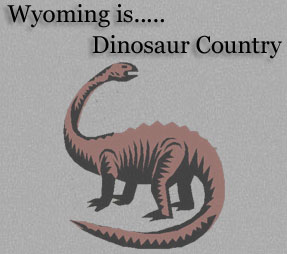 Wyoming's southwestern desert country was once a vast inland sea. Lake Gosiute was the home of a great variety of fish, amphibians, birds reptiles and mammals that are now perfectly fossilized in the shale layers of the ancient sea bed. Fossil Butte National Monument west of Kemmerer explores and presents the flora and fauna of this long gone semi-tropical wonderland. Wyoming's southwestern desert country was once a vast inland sea. Lake Gosiute was the home of a great variety of fish, amphibians, birds reptiles and mammals that are now perfectly fossilized in the shale layers of the ancient sea bed. Fossil Butte National Monument west of Kemmerer explores and presents the flora and fauna of this long gone semi-tropical wonderland.
Wyoming boasts the first major find of dinosaur fossils at Como Bluff near Medicine Bow. Como Bluff bone quarries supplied dinosaur displays to most of the worlds museums during the late 1800s. New discoveries are being made every year. Visitors can experience Wyoming's Jurassic Park at the University of Wyoming Geology Museum in Laramie, the Wyoming State Museum in Cheyenne and at Western Wyoming Community College in Rock Springs.
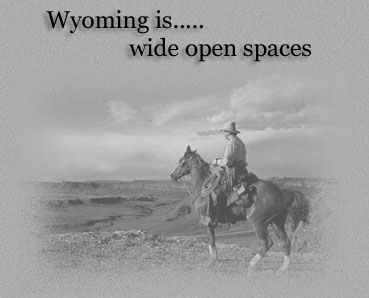
Sparsely populated Wyoming has the smallest population of any state, and almost two thirds of the residents live in urban areas.
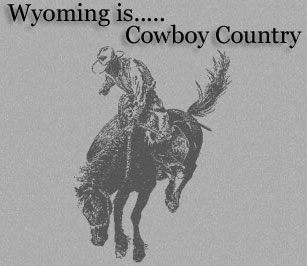
"Wyoming" and "Cowboy" are synonymous. You can't have one without the other. Cowboys drove their great herds of cattle north along the old Texas Trail to the grass-rich prairies of eastern Wyoming in the 1860s. Flocks of sheep were not far behind, heading for the high, semi-desert country of south-central Wyoming.
Huge ranching operations were established, with land holdings measured in thousands of sections, not acres. The Swan Land and Cattle Company, headquartered in Cheyenne and Chugwater, once ran cattle from central Wyoming to west-central Nebraska. Sheep ranches prospered near Rawlins and Rock Springs. At one time, more sheep were sheared at the Wolcott pens than anywhere else in the United States.
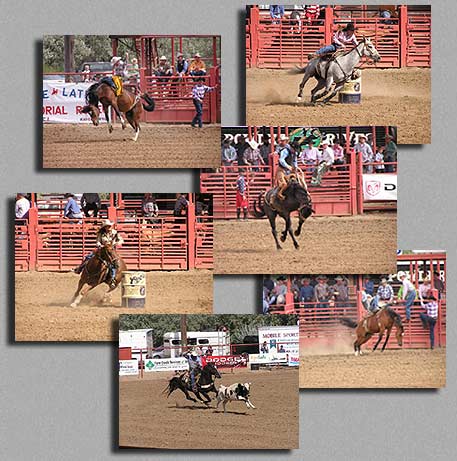
Rodeo is Wyoming's favorite pastime. All along the corridor, communities celebrate the heritage of the cowboy with rodeos of all sizes. Leading the list is Cheyenne Frontier Days, "The Daddy of 'em All." The world's largest outdoor rodeo has been happening for ten days every July for over 100 years. You'll find smaller, "up close and personal" rodeos in places like Pine Bluffs, Laramie, Encampment, Rawlins, Rock Springs, Kemmerer and Evanston, to name a few.
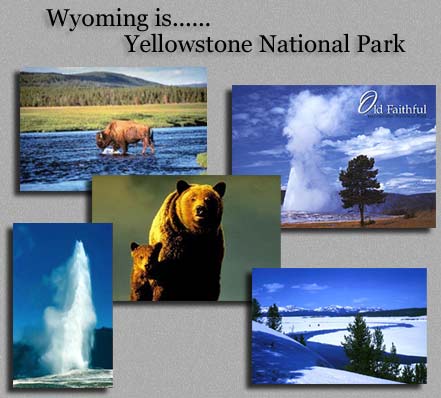
America's First National Park
Long before any recorded human history in Yellowstone, a massive volcanic eruption spewed an immense volume of ash that covered all of the western U.S., much of the Midwest, northern Mexico and some areas of the eastern Pacific. The eruption dwarfed that of Mt. St. Helens in 1980 and left a caldera 30 miles wide by 45 miles long.
That climactic event occurred about 640,000 years ago, and was one of many processes that shaped Yellowstone National Park--a region once rumored to be "the place where hell bubbles up." Geothermal wonders, such as Old Faithful, are evidence of one of the world's largest active volcanoes. These spectacular features bemused and befuddled the park's earliest visitors, and helped lead to the creation of the world's first national park.
Fur trappers' fantastic tales of cauldrons of bubbling mud and roaring geysers sending steaming plumes skyward made their way back east. Several expeditions were sent to investigate, opening the West to further exploration and exploitation. In 1871, Ferdinand Hayden led an expedition that included artist Thomas Moran and photographer William H. Jackson. They brought back images that helped convince Congress that the area known as Yellowstone needed to be protected and preserved.
In 1872, President Ulysses S. Grant signed a law declaring that Yellowstone would forever be "dedicated and set apart as a public park or pleasuring ground for the benefit and enjoyment of the people."
Old Faithful, the most famous of all geysers, erupts more frequently than any of the other big geysers, although it is not the largest or most regular geyser in the park. Its average interval between eruptions is about 91 minutes, varying from 65 - 92 minutes. An eruption lasts 1 1/2 to 5 minutes, expels 3,700 - 8,400 gallons (14,000 - 32,000 liters) of boiling water, and reaches heights of 106 - 184 feet (30 - 55m).
The largest active geyser in the world is Steamboat Geyser in the Norris Geyser Basin.
Old Faithful WebCam

Other Interesting Wyoming Links
Wyoming Ghost Towns
Ridin', Ropin', Ranchin' Cowboy School
Wyoming Pony Express Stations
And lastly, a few important
facts about our featured state....
  
Wyoming is known as the "Equality State" because of the rights women have traditionally enjoyed there. Wyoming women were the first in the nation to vote, serve on juries and hold public office.
In 1869, Wyoming's territorial legislature became the first government in the world to grant "female suffrage" by enacting a bill granting Wyoming women the right to vote. The act was signed into law on December 10 of that year by Governor A.J. Campbell.
Capital. . . . . . . . . . . . . . . . . . . . . . . . . . . . . . . . . . . . . Cheyenne
Nickname. . . . . Big Wyoming, Equality State, Cowboy State
Motto. . . . . . . . . . . . . . . . . . . . . . . . . . . . . . . . . . ."Equal Rights"
Admitted To Union. . . . . . . . . . . . July 10, 1890-44th State
Size. . . . . . . . . . . . . . . . 97,914 square miles, 9th largest state
Highest Point. . . . . . . . . . . . . . . . . Gannett Peak, 13,804 feet
Lowest Point. . . . . . . . . . . . .3,100 feet Belle Fourche River
Average Annual Precipitation. . . . . . . . . . . . . 14.5 inches
Population (2000 Census). . . . . . . . . . . . . . . . . . . . . 493,782

The following websites provided information
and graphics for this presentation...
Tracks Across Wyoming
United States Resources: Wyoming
Wyoming, General Information
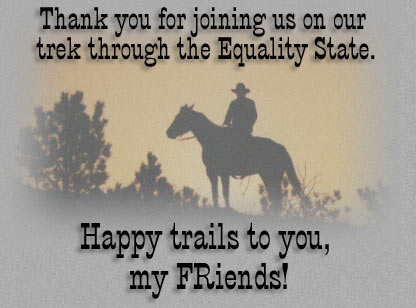
|
|
|
|
|
|




